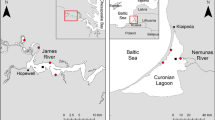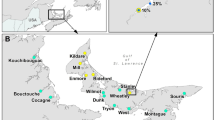Abstract
Data are presented on dissolved oxygen (DO) concentrations and their relationship to salinity, suspended particulate matter (SPM), concentrations, and the turbidity maximum in the Humber-Ouse Estuary, United Kingdom, during summer 1995. Measurements in the upper Humber during March 1995 showed DO in the range 82% to 87% of saturation. Suspended particulate matter concentrations were <5000 mg l−1 and salinity was in the range 0.5 to 12. In contrast, a pronounced DO sag occurred in the upper reaches of the Ouse during medium and spring tide, summer conditions. The DO minimum was essentially an anoxic level and was associated with the location of the turbidity maximum, at salinities between about 0.4 and 1.5. SPM concentrations at 1 m beneath the surface reached 25,000 mg l−1 in the turbidity maximum, between about 20 km and 40 km from the tidal limit. Suspended particulate matter concentrations were much lower at neap tides, although dense suspensions of SPM (>60,000 mg l−1) occurred within 1 m of the bed in the turbidity maximum region. A spring-neap record showed a dramatic and tidally controlled decrease in DO at very low salinities as the tides progressed from neaps to springs. An anchor station located down-channel of the turbidity maximum showed that about 95% of the variance in DO, which varied from 28% at low-water slack to 67% at high-water slack, could be explained in terms of salinity variation. At the up-channel margins of the turbidity maximum, DO increased from zero (anoxia) near high water to 60% near low water slack, in contrast to the behavior down-channel of the turbidity maximum. About 82% of the variance in DO could be explained in terms of salinity variations alone. Only 43% of the DO variance could be explained in terms of SPM alone. Up-channel of the turbidity maximum, SPM concentrations were relatively low (<3000 mg l−1) and DO levels varied from 48% of saturation near high water to 83% near low water slack. About 76% of the variance in DO could be explained in terms of salinity variations alone. Within the turbidity maximum region, DO varied from <2% saturation on the early flood and late ebb and maximized around 7% at high water slack. About 63% of the variance in DO could be explained in terms of salinity variation alone. This increased to 70% when suspended particulate matter was taken into account. Only 29% of the DO variance could be explained in terms of suspended particulate matter alone. Because bacteria were likely to have been the cause of the observed reduction in DO, the numbers of bacteria, both free-living and attached to particles, were measured in the turbidity maximum region. Numbers of free-living bacteria were low and most of the bacteria were attached to sediment particles. There was a linear correlation between total bacterial number and suspended particulate matter concentration, suggesting that the strong DO demand was exerted locally as a result of bacterial activity associated with increased suspended particulate matter concentrations. An order of magnitude analysis of DO consumption within the Ouse’s turbidity maximum, based on the premise that DO depletion was directly related to suspended particulate matter concentrations and that DO addition was due to reaeration, indicates that complete deoxygenation could have occurred with an oxygen depletion rate of ∼0.01 mg DO h−1/g suspended particulate matter during the residence time of waters within the turbidity maximum (∼7 d). This rate was sufficiently fast that anoxic to aerobic conditions were able to develop a spring-neap periodicity within the turbidity maximum, but too slow to generate substantial intratidal fluctuations in DO. This is in accordance with the observations, which show that relatively little of the intratidal variance in DO could be explained in terms of suspended particulate matter fluctuations, whereas most of the variance could be explained in terms of salinity, which behaved as a surrogate measure for the proximity of the turbidity maximum.
Similar content being viewed by others
Literature cited
Bent, E. J. andR. Goulder. 1981. Planktonic bacteria in the Humber Estuary; Seasonal variation in population density and heterotrophic activity.Marine Biology 62:35–45.
Boicourt, W. C. 1992. Influences of circulation processes on dissolved oxygen in Chesapeake Bay, p. 7–59.In D. E. Smith, M. Leffler, and G. Mackieman (eds.), Oxygen Dynamics in the Chesapeake Bay. Maryland Sea Grant College, College Park, Maryland.
Chittenden, W. H. andS. A. Freudberg. 1987. A dissolved oxygen study of the upper Potomac Estuary, A report on behalf of the Potomac Studies Policy Committee, Metropolitan Washington Council of Governments, Washington, D.C.
Clarke, K. R. andI. R. Joint. 1986. Methodology for estimating numbers of free-living and attached bacteria in estuarine water.Applied and Environmental Microbiology 51:1110–1120.
Es, F. B. van andP. Ruardij. 1982. The use of a model to assess factors affecting the oxygen balance in the waters of the Dollard.Netherlands Journal of Sea Research 15:313–330.
Gameson, A. L. H. 1982. The quality of the Humber Estuary: A review of the results of monitoring 1961–1981. Yorkshire Water Authority, Leeds, United Kingdom.
Goulder, R. 1976. Relationships between suspended solids and standing crops and activities of bacteria in an estuary during a spring-neap tidal cycle.Oecologia 24:83–90.
Heip, C. H. R., N. K. Goosen, P. M. J. Herman, J. Kromkamp, J. J. Middelburg, andK. Soetaert. 1995. Production and consumption of biological particles in temperate tidal estuaries, p. 1–150.In A. D. Ansell, R. N. Gibson, and M. Barnes (eds.), Oceanography and Marine Biology—An Annual Review, 33. UCL Press, London.
Humber Estuary Committee. 1993. Humber Estuary Quality Report 1993, edition 2. Humber Estuary Committee, National Rivers Authority (Humber Estuary Committee was renamed Environment Agency in 1996), Leeds, Yorkshire, United Kingdom.
HMSO. 1949. Pollution of the Humber. Fisheries Investigations, Series 1, 5, No. 4, Ministry of Agriculture and Fisheries. His MajestyVs Stationary Office, London, United Kingdom.
Hydraulics Research. 1983. Tolo Harbour water quality model, QUEST 2, A three-dimensional water quality and ecosystem model, Report EX 1140, Hydraulics Research Ltd, Wallingford, United Kingdom.
Jackson, R. H., P. J. le B. Williams, andI. R. Joint. 1987. Freshwater phytoplankton in the low salinity region of the River Tamar Estuary.Estuarine, Coastal and Shelf Science 25:299–311.
Jonas, R. 1992. Microbial processes, organic matter and oxygen demand in the water column, p. 113–148.In D. E. Smith, M. Leffler, and G. Mackiernan (eds.), Oxygen Dynamics in the Chesapeake Bay. Maryland Sea Grant College, College Park, Maryland.
Kennish, M. J. 1986. Ecology of Estuaries: Volume 1, Physical and Chemical Aspects. CRC Press, Inc., Boca Raton, Florida.
Morris, A. M., D. H. Loring, A. J. Bale, R. J. M. Howland, R. F. C. Mantoura, andE. M. S. Woodward. 1982. Particle dynamics, particulate carbon and the oxygen minimum in an estuary,Oceanologica Acta 5:349–353.
Morris, A. M., R. J. M. Howland, E. M. S. Woodward, A. J. Bale, andR. F. C. Mantoura. 1985. Nitrite and ammonia in the Tamar Estuary.Netherlands Journal of Sea Research 19:217–222.
Owens, N. J. P. 1986. Estuarine nitrification: A naturally occurring fluidized bed reaction.Estuarine, Coastal and Shelf Science 22:31–44.
Peterson, D. H. 1979. Sources and sinks of biologically reactive oxygen, carbon, nitrogen and silica in northern San Francisco Bay, p. 175–193.In San Francisco Bay: The Urbanized Estuary. Pacific Division of the American Association for the Advancement of Science, San Francisco, California.
Pomroy, A. P. 1984. Direct counting of bacteria preserved with Lugol iodine solution.Applied and Environmental Microbiology 47:1191–1192.
Swanson, R. L., C. I. Sindermann, andG. Han. 1980. Oxygen depletion and the future: An evaluation, Chapter 16, p. 335–345.In Oxygen Depletion and Associated Benthic Mortalities in New York Bight. NOAA Professional Paper 11. National Oceanic and Atmospheric Administration, Rockville, Maryland.
Thouvenin, B., P. Le Hir, andL. A. Romana. 1994. Dissolved oxygen model in the Loire Estuary, p. 169–178.In K. R. Dyer and R. J. Orth (eds.), Changes in Fluxes in Estuaries, Implications from Science to Management. Olsen and Olsen, Fredensborg, Denmark.
Woodward, G. M. 1984. Pollution control in the Humber Estuary.Water Pollution Control 83:82–90.
Unpublished materials
Chester, M. A. 1997. Personal Communication. Department of Civil and Structural Engineering, University of Sheffield, Sir Frederick Mappin Building, Mappin Street, Sheffield, S1 4DU, United Kingdom.
Freestone, R. 1996. Personal Communication. Environment Agency (Yorkshire), Rivers House, 21 Park Square South, Leeds LS1 2QG, United Kingdom.
Harris, J. R. W. 1989. Roadford environmental investigation: Water quality model of the Tamar Estuary. Unpublished Report by Plymouth Marine Laboratory, United Kingdom to the Southwest Water Authority. Plymouth, United Kingdom.
Author information
Authors and Affiliations
Rights and permissions
About this article
Cite this article
Uncles, R.J., Joint, I. & Stephens, J.A. Transport and retention of suspended particulate matter and bacteria in the Humber-Ouse Estuary, United Kingdom, and their relationship to hypoxia and anoxia. Estuaries 21, 597–612 (1998). https://doi.org/10.2307/1353298
Received:
Accepted:
Issue Date:
DOI: https://doi.org/10.2307/1353298




